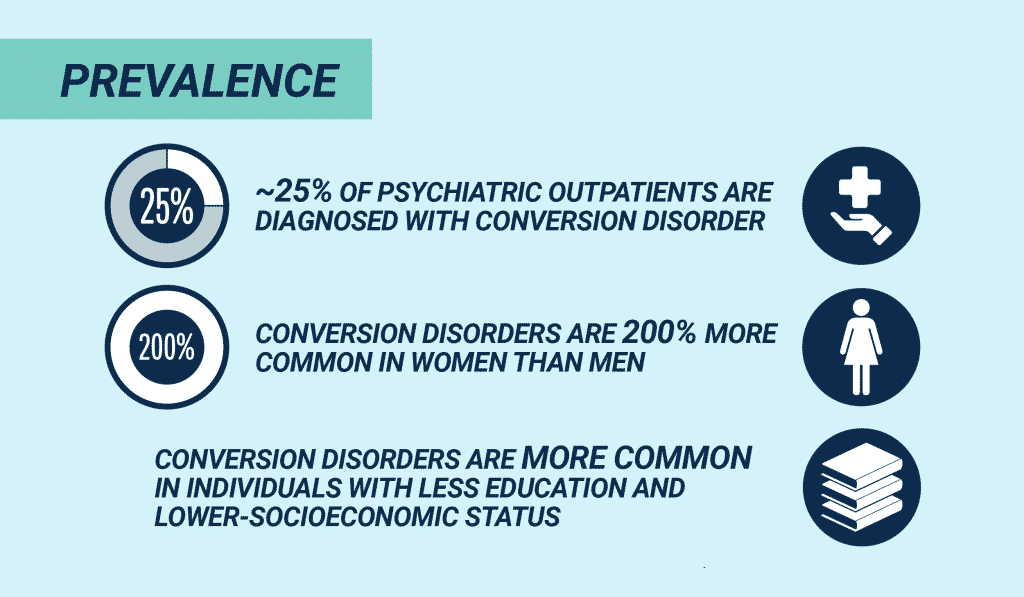Conversion disorder statistics reveal the physical and emotional toll this condition carries, as well as the economic burden it puts on the United States.
Conversion disorderis a mental health condition where emotional problems are converted into physical symptoms. Common symptoms include paralysis, blindness, seizures, swallowing difficulties, motor tics and difficulty walking. These physical symptoms cannot be explained by an underlying neurological or medical health condition.
The effects of conversion disorder go beyond physical and psychological distress. Approximately82%of people with conversion disorder stop working due to symptoms. This loss in productivity adds up to $20 billion USD spent annually on this condition. Diagnosis can prove difficult as well, as conversion disorder can co-exist with physical illness in60%of patients.
Prevalence of Conversion Disorder
The basis of conversion disorder symptoms stems from psychological problems that could be from current or past unresolved issues. Conversion disorder can be triggered by physical, emotional or sexual abuse. Research indicates thatrisk factorsinclude being part of a rural population, lacking education, being female, being lower socioeconomic status and being young.
Statistics show that conversion disorder prevalence is significant in the United States:
Treatment Can Be Life Changing. Reach out today.
Whether you are struggling with addiction, mental health or both, our expert team is here to guide you every step of the way. Don’t wait— reach out today to take the first step toward taking control of your life.
- Lifetime prevalence rates of conversion disorder are between11–300 per 100,000 people
- 5–14%of general hospital patients are diagnosed with conversion disorder
- 1–3%of outpatient referrals to psychiatrists are diagnosed with conversion disorder
- 5–25%of psychiatric outpatients are diagnosed with conversion disorder
- An estimated20–25%of those in a hospital setting meet some of the criteria for conversion disorder diagnosis
- Conversion disorders aremore commonin adult women than men, with at least twice the number of women diagnosed with conversion disorder than men
- Conversion disorders are more common in populations of individuals that haveless educationand lower socioeconomic status
- Compared to developed countries, third-world or developing countries can have up to a31%prevalence rate

Occurrence of Misdiagnosis
A large number of people with conversion disorder also have aco-occurring medical condition, making it difficult to receive a diagnosis. A thorough psychiatric evaluation is required to obtain a detailed medical history, including onset of symptoms, co-occurring conditions and otherstressfactors. This general health workup is also necessary to rule out any physical illness that the symptoms of a conversion disorder may mimic.
Conversion disorder symptoms are often mistaken for the following health conditions:
- Multiple sclerosis
- Myasthenia gravis
- Periodic paralysis
- Polymyositis
- Stroke
- Spinal cord injury
- Lupus
In addition to ruling out physical health conditions, other psychological disorders should be ruled out as well before a diagnosis of conversion disorder is given, including:
- Hypochondriasis
- Factitious disorder
- Somatization
- Malingering
The failure to diagnose conversion disorder can have negative consequences for the affected individual and delay vital treatment.
Rates of Conversion Disorder and Co-Occurring conditions
Conversion disorder can occur alongside othermental healthconditions. These co-occurring conditions must also be treated for the best possible outcome.
Some of the most common conditions that co-occur with conversion disorder include:
- Depression:Inone studydepression and conversion disorder occurred together in 29% of people
- Anxiety:Researchshows that conversion disorder andanxietyoccurred together in about 35% of cases
- Dissociative Disorders:Bothdissociative disordersand conversion disorder can develop after childhood trauma
- PTSD:PTSDhas at least one traumatic event that triggers the condition; conversion disorder can also stem from trauma or stressors

Conversion Disorder Prognosis
Conversion disorder prognosis is best when the symptoms have an acute onset, short duration, a known trigger or stressor, and no other co-occurring conditions. Receiving treatment from a qualified therapist also dramatically improves conversion disorder prognosis. Most acute onsets of conversion disorder resolve within weeks, but25%of people who have acute conversion disorder symptoms also have recurring symptoms within a year.
Prognosis outlook is diminished when conversion disorder has been present for over a year with recurring symptoms. Comorbidity may also be increased among those who have symptoms lasting over a year.
Statistics on Conversion Disorder Treatment
The besttreatment for conversion disorderstarts with how the diagnosis is presented to the affected individual. Because the symptoms are causing physical and neurological disabilities, telling someone “it’s all in their head” can make symptoms worse. At the same time, conversion disorder treatment success is reliant on the person recognizing the psychological connection to their physiological symptoms.
Effective treatment for conversion disorder includes:
- Psychotherapy:Methods likecognitive behavioral therapyand group can be employed to shed light on underlying emotions and methods of coping
- Physical therapy:Research shows this to be an effective method of treatment to help the person overcome their physical symptoms
- Medications:While no medication can treat conversion disorder alone, medication can help address the underlying symptoms of co-occurring conditions, likedepressionor anxiety
If you or someone you know lives with co-occurringconversion disorder and addiction, we encourage you to get in touch with us at The Recovery Village.Contact ustoday to discuss possible treatment options.









